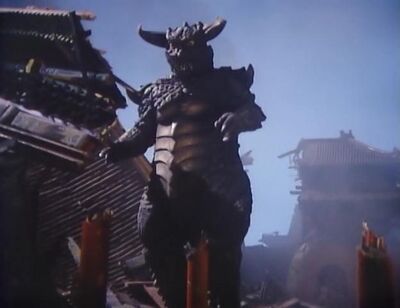
Came from nowhere, going nowhere.
While the North Korean epic Pulgasari (1985) is sometimes mentioned as a monster movie, this is actually a straightforward fable concerning the tradeoffs necessary for survival in times when men are ambitious and food may be scarce. It is also a condemnation of the hard, exploitative feudal system from which Korea transitioned following the Japanese invasions of World War II.
An unnamed village, supposedly under the protection of the local King, is instead preyed upon by its appointed Governor, who has stripped the village of food and men. Now he needs weapons, as the locals are in revolt. He travels to visit the village blacksmith and demands immediate service. When the blacksmith points out he lacks the iron to make the requested weapons, the blacksmith’s village is stripped of the farming implements necessary to grow the food for the village.
The confiscated tools are then stolen and once the governor learns of it, he blames the blacksmith and imprisons him without food. Scraps of rice are surreptitiously thrown to him by his children, and he shapes the rice into a toy creature. With his last noble breath, imbues the figure with life. His daughter later finds it and accidentally cuts herself. A drop of her blood completes the process of animating the figure. She names the tiny black figurine Pulgasari.
But this is not a monster that magically grows big. No, in order to grow, Pulgasari, which might be called an Eastern Minotaur, must consume iron. Any handy sword or tool will do, and these are presented in plenty when the governor’s troops come to destroy him. Munching his way through swords, spears and pitchforks, he’s soon standing 40 feet tall.
There is quite the sophisticated war, as the King, now involved, has no intention of giving up his possessions or position, while the farmers, emboldened by Pulgasari, are loathe to give up the gains made possible by their pet monster. But as the war continues, iron continues to disappear into the maw of Pulgasari, and the farmers find it harder and harder to find the tools to grow food. In the end, Pulgasari may have helped free them from the tyranny of the King, but now they face starvation. What will they do with their ally?
Technically speaking, I was expecting far worse from a North Korean movie. True, the visuals and audio are somewhat blotchy, but the acting wasn’t awful; more along the lines of some of the better Asian karate movies of the period. Pulgasari himself could have been better constructed, but as rubber-suit monsters go, he was far from the worst I’ve seen. I appreciated the attention given to the symbols of war and farming as forces in a dynamic tension that, ill-managed, can result in excess suffering. The director and writers of the movie may be reaching for even more symbolism, which I, as an American, may have missed.
Another political observation: this is a tug-of-war of the extreme narcissism and greed of the upper classes vs. the collectivism of the village. Neither is a happy situation, as the former exploit the villages, but the collectivist mentality inevitably morphs into self-preservation for the collectivist entity as a whole that, sadly, grinds the villagers into dust. None of the original leading members of the villagers actually survives to the end of the movie, having sacrificed themselves for the greater good. The message, even if unintended, lends quite the noir atmosphere to the movie.
I don’t recommend it unless you have some interest in a movie that was made by a pair of hostages under the guidance of their kidnapper, North Korean dictator Kim Jong-il, who is listed as the film’s producer.
But in case you’re intrigued, here it is in its entirety:




